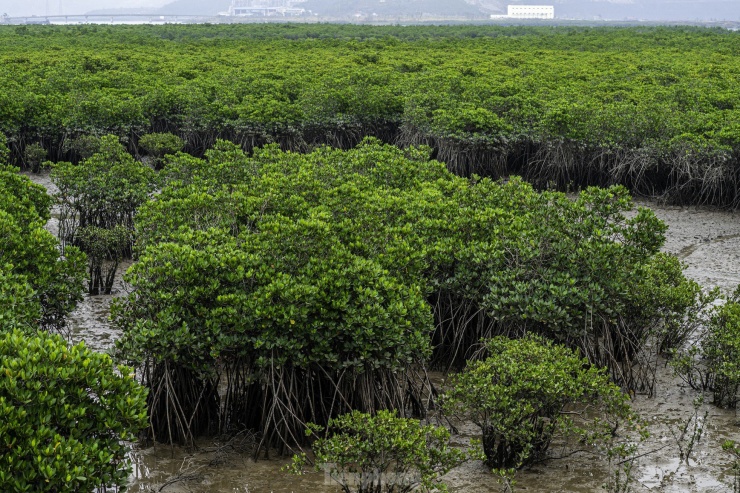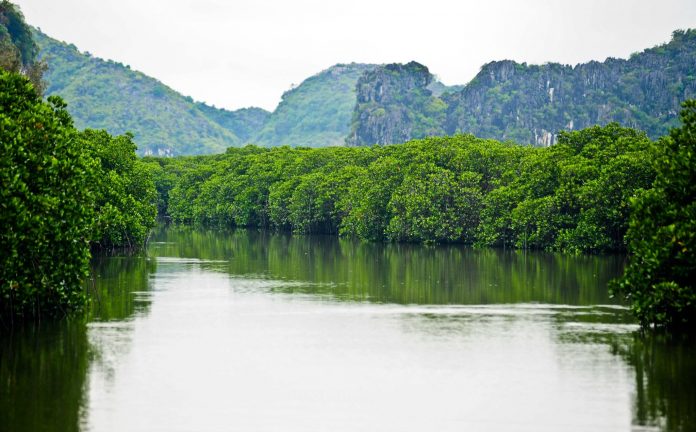Mangrove forests in Ha Long Bay
As we all know, Ha Long Bay, with an area of 1,553 km² and comprising 1,969 islands of unique and fascinating shapes, features caves as beautiful as those found in legends. It has twice been recognized by UNESCO as a World Natural Heritage Site - for its aesthetic value in 1994 and for its geological and geomorphological value in 2000.
In addition to these two recognized values, Ha Long Bay holds another extremely significant one: its biodiversity value. The biodiversity of Ha Long Bay is not only rich in terms of species and genetic resources, but also in the diversity of its ecosystems. According to scientific research, there are ten typical types of ecosystems found in the Bay - characteristic of tropical limestone island archipelagos - stretching from underwater areas up to the peaks of the rocky islands. Each ecosystem plays a different role in creating the unique landscape complex of Ha Long.
Among these, one especially important ecosystem is the Mangrove forest Ecosystem.

Mangrove Forests (MF) are forested areas consisting of various types of trees that grow in coastal saltwater zones in tropical and subtropical regions. Most of these areas are exposed during low tide and submerged when the tide rises. Due to such harsh conditions, only certain mangrove species with specific characteristics can adapt and thrive.
Quang Ninh’s coastline stretches over 250 kilometers, with many fragmented sections interspersed with river mouths, creating favorable conditions for the development of mangrove trees in particular and wetland vegetation in general. The mangrove forests in Quang Ninh extend from the Bach Dang estuary (Quang Yen) to Tra Co (Mong Cai), featuring a rich variety of wetland plant species such as Bruguiera, Rhizophora, Avicennia, Sonneratia, and especially Aegiceras, which dominates the area.
In Ha Long Bay, mangrove forests are mainly concentrated in areas like Tuan Chau Island, Cua Luc, Dau Go Island, Chan Voi, Ba Cua Inlet, Cai Lan Inlet, the border area with Cat Ba, and scattered along the shoreline. Scientists have recorded that the mangrove ecosystems in Ha Long and nearby areas are home to 19 species of mangrove plants and nearly 500 species of organisms.
According to scientists, mangrove forests play a vital role in protecting coastal river mouths and mitigating the impacts of storms and winds, acting as a "natural shield" to safeguard the lives and livelihoods of coastal fishermen. They also play an active role in environmental treatment, reducing the concentration of heavy metals in domestic wastewater discharged into coastal estuaries, thereby contributing to environmental purification. Mangroves are nurseries and habitats for many species of flora and fauna, including numerous high-value seafood species such as shrimp, crabs, clams, and ngan (a local bivalve mollusk). They provide shelter, feeding grounds, and refuge for various species. With their dense and tangled root systems, mangroves significantly contribute to sedimentation and land accretion, expanding land resources for coastal areas while also mitigating the impact of waves and storms.
Currently, there are two major mangrove forest areas in Ha Long Bay: the area in front of Dau Go Cave and the Ba Cua Inlet. Many of the Bruguiera and Aegiceras trees here are around 2 meters tall. In fact, local fishermen have even caught crabs and ngan in this area.

Given the important roles mentioned above, it is clear that mangrove forests (MF) provide numerous benefits and positive effects. However, the increasingly complex and unpredictable developments of natural disasters, the warming of the Earth’s temperature, and the continuous rise in sea levels raise a pressing question: how can we protect, restore, and replant mangrove forests that have been destroyed, while also expanding new forested areas? This remains a difficult challenge.
Both natural and human-induced impacts have led to the gradual shrinking of mangrove ecosystems. Urban expansion, aquaculture, factory construction, and other development activities have resulted in the loss of many mangrove areas. For economic gain and livelihood, mangroves may be cut down if there is no close supervision and protection.
To preserve the ecosystem of Ha Long Bay (HLB), concerted efforts from all levels of government-both central and local-international organizations, the business community, and especially local residents working in and around the Bay are crucial. In recent years, mangrove reforestation and protection efforts in many localities have yielded positive results. Specifically, the Ha Long Bay Management Department, in collaboration with JICA (Japan International Cooperation Agency), has implemented mangrove planting projects in the Bay with the goal of improving the Bay's environment.
Initiated in 2009, this program has since become an annual event aimed at raising youth awareness about protecting the natural landscape. It also helps educate the community on the importance and role of mangrove forests, fostering a shared responsibility in preserving the environment of Ha Long Bay-a World Natural Heritage site and Wonder of Nature.
Beyond planting mangroves, activities such as protecting water quality, collecting and treating waste in Ha Long Bay are also extremely important.
To conserve Ha Long Bay and preserve the blue of the sea, let us join hands in planting, caring for, and protecting mangrove forests, along with all of the Bay’s unique ecosystems. This is one of the most meaningful actions we can take to responsibly interact with a World Natural Heritage Site and ensure Ha Long stays green forever.
Translated by Thuy Ha
